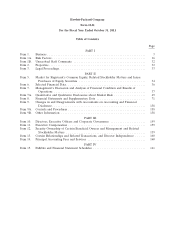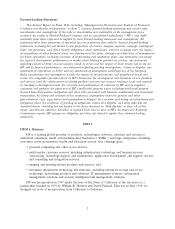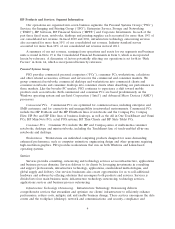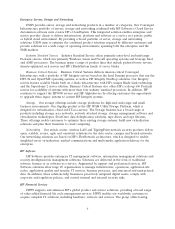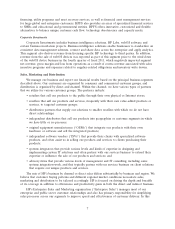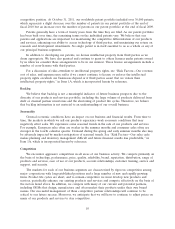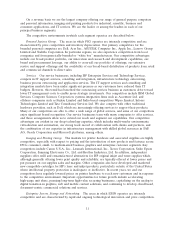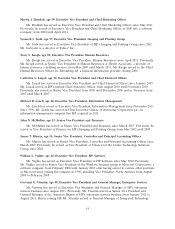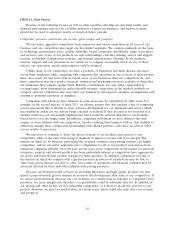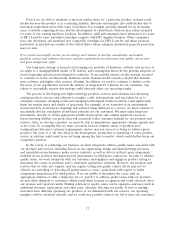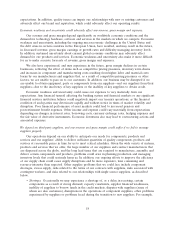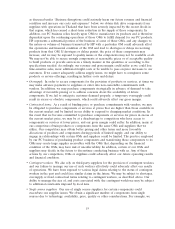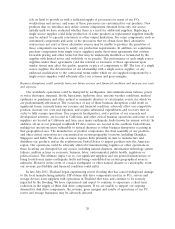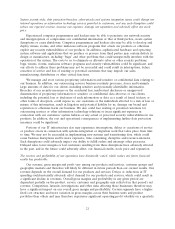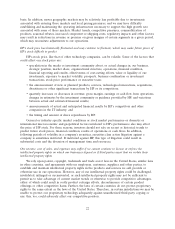HP 2011 Annual Report Download - page 20
Download and view the complete annual report
Please find page 20 of the 2011 HP annual report below. You can navigate through the pages in the report by either clicking on the pages listed below, or by using the keyword search tool below to find specific information within the annual report.Our competitors range from broad solution providers such as International Business Machines
Corporation (‘‘IBM’’) to more focused competitors such as EMC Corporation and NetApp, Inc. in
storage and Dell, Inc. in industry standard servers. We believe that our important competitive
advantages in this segment include the six technology components of our converged infrastructure
initiatives: IT systems, power and cooling, security, management, virtualization and automation. We
believe that our competitive advantages also include our global reach and our significant intellectual
property portfolio and research and development capabilities, which will contribute to further
enhancements of our product and service offerings and our ability to cross-sell our portfolio and
leverage scale advantages in everything from brand to procurement leverage.
HP Software. The areas in which HP Software operates are fueled by rapidly changing customer
requirements and technologies. We market enterprise IT management software in competition with
IBM, CA, Inc., BMC Software, Inc. and others. Our information management solutions compete with
products from companies like IBM, EMC, and Symantec Corporation. We also deliver enterprise
security/risk intelligence solutions that compete with products from Symantec, IBM, Cisco, and McAfee.
As new delivery mechanisms such as software-as-a-service come on the scene, we are also confronting
less traditional competitors. Our differentiation lies in the breadth and depth of our software and
services portfolio and the scope of our market coverage.
HP Financial Services. In our financing business, our competitors are captive financing companies,
mainly IBM Global Financing, as well as banks and financial institutions. We believe our competitive
advantage in this business over banks and financial institutions is our ability to finance products,
services and total solutions.
For a discussion of risks attendant to these competitive factors, see ‘‘Risk Factors—Competitive
pressures could harm our revenue, gross margin and prospects,’’ in Item 1A, which is incorporated
herein by reference.
Environment
Our operations are subject to regulation under various federal, state, local and foreign laws
concerning the environment, including laws addressing the discharge of pollutants into the air and
water, the management and disposal of hazardous substances and wastes, and the cleanup of
contaminated sites. We could incur substantial costs, including cleanup costs, fines and civil or criminal
sanctions, and third-party damage or personal injury claims, if we were to violate or become liable
under environmental laws.
Many of our products are subject to various federal, state, local and foreign laws governing
chemical substances in products and their safe use, including laws regulating the manufacture and
distribution of chemical substances and laws restricting the presence of certain substances in electronics
products. Some of our products also are, or may in the future be, subject to requirements applicable to
their energy consumption. In addition, we face increasing complexity in our product design and
procurement operations as we adjust to new and future requirements relating to the chemical and
materials composition of our products, their safe use, and their energy efficiency, including
requirements relating to climate change. We also are subject to legislation in an increasing number of
jurisdictions that makes producers of electrical goods, including computers and printers, financially
responsible for specified collection, recycling, treatment and disposal of past and future covered
products (sometimes referred to as ‘‘product take-back legislation’’). In the event our products become
non-compliant with these laws, they could be restricted from entering certain jurisdictions, and we
could face other sanctions, including fines.
Our operations and ultimately our products are expected to become increasingly subject to federal,
state, local and foreign laws and regulations and international treaties relating to climate change. As
these laws, regulations and treaties and similar initiatives and programs are adopted and implemented
12


